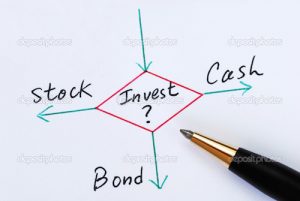Should I worry about bonds?
 Yes. When interest rates go up, the value of existing bonds fall. Period. So with rates historically low today, holding bonds may be riskier now than we have grown to expect over the last several decades. Here’s how we got here and how you can get through the future of interest rates without knowing where rates will go or when.
Yes. When interest rates go up, the value of existing bonds fall. Period. So with rates historically low today, holding bonds may be riskier now than we have grown to expect over the last several decades. Here’s how we got here and how you can get through the future of interest rates without knowing where rates will go or when.
A world upside down
As interest rates have gone almost straight down for 34 years now, bond investors have ridden on an unbroken boulevard of investment green lights. Anyone who has bought and held bonds has been right and anyone who has sold has been wrong. Will it continue? No one knows. Bond bears have been calling the top for at least five years now. Bill Gross was dethroned as the Bond King because he guessed wrong – twice – on interest rates.
But can low rates keep going lower? International markets tell us it’s possible, if not probable. Japan has lived with zero to one percent interest rates for 20 years. More than one third of Europe’s bond market now has negative interest rates. Like water flowing uphill and the Higgs boson, negative interest rates were thought to be a condition that could never exist in reality. If you are one of those who believe that rates have to go up and at least can’t go any lower, visit Tokyo, the land of deflation. Or Zurich, home of negative interest rates.
Shifts happen
Let’s say you are one of those who thinks interest rates could go up, say, sometime in the unpredictable future. In truth, you can’t know the timing of a tectonic rate shift. Such shifts are rare. In 35+ investment years I’ve experienced only one and that was April 1981. At that time, as inflation hit 14.7%, 30 year Treasuries were at 15% and money markets at 21%. The conventional wisdom was that rates would keep going up. However, Spring of 1981 was the unknown and unpredicted peak of rates and here we are 34 years later with 3% 30 year Treasury rates and no inflation.
Be afraid, be very afraid….
Bonds are controlled by the inescapable mathematics of numbers: rate, maturity, rating, and so on. That makes it very easy to see how bond prices are set. In this super-low rate world there are three primary threats to bondholders, all easily identifiable. They are:
- Default risk
- Rate risk
- Spread risk
Simply put, default risk is the amount of money investors lose when bondholders default. Default losses must be subtracted from total return to get actual return. Historically, default losses go as low as one percent in good times (like now) to 12 percent in bad times (deep, persistent recession). The enormous amount of money flowing into junk bonds is at risk of default rate change.
Spread risk is the difference in bond returns due to quality rating. AAA bonds have the lowest returns, junk bonds the highest with the difference being the “spread.” Right now spreads are not just compressed, they are squashed. Spread represents compensation for accepting more risk. Spreads widen and contract over time by some kind of tidal force. It’s natural. Right now, it’s high tide in the bond market and when the tide goes out….well, you know what happens next.
Rate risk is simply the change in price for a given change in interest rates. Again, the arithmetic here is inexorable. There is no hiding from bond math; the price is the price. For 34 years bond prices have gone up as rates have declined. That movie can also go backwards, rising rates, falling prices
What to do now
Investors can do themselves the biggest favor by simply being aware. First, be aware of return and of risk. There are plenty of fact-based sources of information on both. Secondly, scenario planning is essential. A sensitivity analysis (bond market jargon) is de rigeur for big bond investors, so ask your advisor for one. It will help you understand how the value of your bonds will change based on various potential interest rate changes. Lastly, question how bonds fit into your portfolio “required rate of return,” the overall return you must earn on all investments to reach your goals. By definition, any money you have in bonds has to be offset by harder working higher return investments in order to meet your required rate of return. What’s your risk? The answer is out there.
If you don’t feel like you can find that answer on your own, we can help.
John Osbon – josbon@osboncapital.com
Weekly Articles by Osbon Capital Management:
"*" indicates required fields

